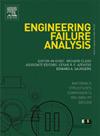Failure analysis on fusing of power cable in main transformer control circuit for nuclear power plant
IF 5.7
2区 工程技术
Q1 ENGINEERING, MECHANICAL
引用次数: 0
Abstract
The main transformer control circuit is used to control and distribute electric power, and its reliability plays an important role in normal and stable operation of a nuclear power plant. In this paper, an unexpected fusing failure occurring on one power cable inside the cabinet of the main transformer control circuit of a nuclear power plant was addressed. By means of comprehensive investigation including morphologies observation of the fused area, materials characterization of the copper conductor and polymer insulation sheath, and compositions analysis of the corrosion products, it was identified that the failure was mainly resulted from the multiple factors in the manufacturing, installation and operation procedures. Under this condition, the root cause and contributing factors of the failure were determined, and a vicious circle that was originated from mechanical damage, accelerated by electrochemical corrosion, and functioned via heat accumulation was proposed to describe the failure process and relevant mechanisms. Based on the analysis results, the countermeasures were proposed, which would have reference values for failure prevention of power cables serving under similar environments.
核电站主变压器控制回路电力电缆熔断故障分析
主变控制电路用于控制和分配电力,其可靠性对核电站的正常稳定运行起着重要作用。本文针对某核电站主变压器控制回路柜内一根电力电缆发生的意外熔断问题进行了分析。通过熔接区形貌观察、铜导体和聚合物绝缘护套材料表征、腐蚀产物成分分析等综合调查,确定其失效主要是由制造、安装和操作过程中的多重因素造成的。在此条件下,确定了失效的根本原因和影响因素,提出了由机械损伤引发、电化学腐蚀加速、热积累作用的恶性循环来描述失效过程和相关机制。根据分析结果,提出了相应的预防措施,对类似环境下电力电缆的故障预防具有参考价值。
本文章由计算机程序翻译,如有差异,请以英文原文为准。
求助全文
约1分钟内获得全文
求助全文
来源期刊

Engineering Failure Analysis
工程技术-材料科学:表征与测试
CiteScore
7.70
自引率
20.00%
发文量
956
审稿时长
47 days
期刊介绍:
Engineering Failure Analysis publishes research papers describing the analysis of engineering failures and related studies.
Papers relating to the structure, properties and behaviour of engineering materials are encouraged, particularly those which also involve the detailed application of materials parameters to problems in engineering structures, components and design. In addition to the area of materials engineering, the interacting fields of mechanical, manufacturing, aeronautical, civil, chemical, corrosion and design engineering are considered relevant. Activity should be directed at analysing engineering failures and carrying out research to help reduce the incidences of failures and to extend the operating horizons of engineering materials.
Emphasis is placed on the mechanical properties of materials and their behaviour when influenced by structure, process and environment. Metallic, polymeric, ceramic and natural materials are all included and the application of these materials to real engineering situations should be emphasised. The use of a case-study based approach is also encouraged.
Engineering Failure Analysis provides essential reference material and critical feedback into the design process thereby contributing to the prevention of engineering failures in the future. All submissions will be subject to peer review from leading experts in the field.
 求助内容:
求助内容: 应助结果提醒方式:
应助结果提醒方式:


